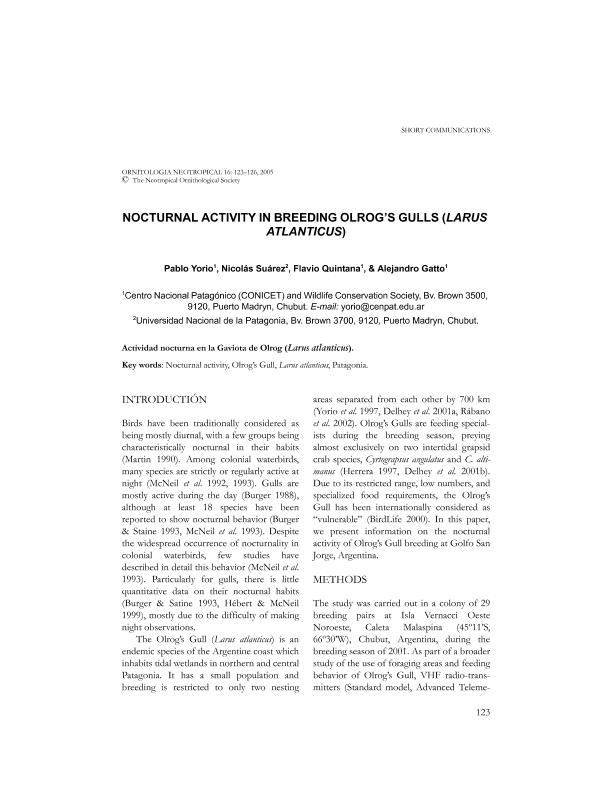Mostrar el registro sencillo del ítem
dc.contributor.author
Yorio, Pablo Martin

dc.contributor.author
Suarez, Nicolas Marcelo

dc.contributor.author
Quintana, Flavio Roberto

dc.contributor.author
Gatto, Alejandro Javier

dc.date.available
2020-06-25T15:09:15Z
dc.date.issued
2005-12
dc.identifier.citation
Yorio, Pablo Martin; Suarez, Nicolas Marcelo; Quintana, Flavio Roberto; Gatto, Alejandro Javier; Actividad nocturna en la Gaviota de Olrog (Larus atlanticus); Neotropical Ornithological Society; Ornitología Neotropical; 16; 12-2005; 123-126
dc.identifier.issn
1075-4377
dc.identifier.uri
http://hdl.handle.net/11336/108211
dc.description.abstract
Birds have been traditionally considered as being mostly diurnal, with a few groups being characteristically nocturnal in their habits (Martin 1990). Among colonial waterbirds, many species are strictly or regularly active at night (McNeil et al. 1992, 1993). Gulls are mostly active during the day (Burger 1988), although at least 18 species have been reported to show nocturnal behavior (Burger & Staine 1993, McNeil et al. 1993). Despite the widespread occurrence of nocturnality in colonial waterbirds, few studies have described in detail this behavior (McNeil et al. 1993). Particularly for gulls, there is little quantitative data on their nocturnal habits (Burger & Satine 1993, Hébert & McNeil 1999), mostly due to the difficulty of making night observations. The Olrog’s Gull (Larus atlanticus) is an endemic species of the Argentine coast which inhabits tidal wetlands in northern and central Patagonia. It has a small population and breeding is restricted to only two nesting areas separated from each other by 700 km (Yorio et al. 1997, Delhey et al. 2001a, Rábano et al. 2002). Olrog’s Gulls are feeding specialists during the breeding season, preying almost exclusively on two intertidal grapsid crab species, Cyrtograpsus angulatus and C. altimanus (Herrera 1997, Delhey et al. 2001b). Due to its restricted range, low numbers, and specialized food requirements, the Olrog’s Gull has been internationally considered as “vulnerable” (BirdLife 2000). In this paper, we present information on the nocturnal activity of Olrog’s Gull breeding at Golfo San Jorge, Argentina.
dc.format
application/pdf
dc.language.iso
eng
dc.publisher
Neotropical Ornithological Society

dc.rights
info:eu-repo/semantics/openAccess
dc.rights.uri
https://creativecommons.org/licenses/by-nc-sa/2.5/ar/
dc.subject
Nocturnal feeding
dc.subject
Olrog's Gull
dc.subject.classification
Ecología

dc.subject.classification
Ciencias Biológicas

dc.subject.classification
CIENCIAS NATURALES Y EXACTAS

dc.title
Actividad nocturna en la Gaviota de Olrog (Larus atlanticus)
dc.title
Nocturnal activity in breeding olrogs gulls (Larus atlanticus)
dc.type
info:eu-repo/semantics/article
dc.type
info:ar-repo/semantics/artículo
dc.type
info:eu-repo/semantics/publishedVersion
dc.date.updated
2020-05-15T15:56:21Z
dc.journal.volume
16
dc.journal.pagination
123-126
dc.journal.pais
Canadá

dc.description.fil
Fil: Yorio, Pablo Martin. Consejo Nacional de Investigaciones Científicas y Técnicas. Centro Científico Tecnológico Conicet - Centro Nacional Patagónico; Argentina
dc.description.fil
Fil: Suarez, Nicolas Marcelo. Universidad Nacional de la Patagonia "San Juan Bosco"; Argentina
dc.description.fil
Fil: Quintana, Flavio Roberto. Consejo Nacional de Investigaciones Científicas y Técnicas. Centro Científico Tecnológico Conicet - Centro Nacional Patagónico; Argentina
dc.description.fil
Fil: Gatto, Alejandro Javier. Consejo Nacional de Investigaciones Científicas y Técnicas. Centro Científico Tecnológico Conicet - Centro Nacional Patagónico; Argentina
dc.journal.title
Ornitología Neotropical

dc.relation.alternativeid
info:eu-repo/semantics/altIdentifier/url/https://sora.unm.edu/sites/default/files/journals/on/v016n01/p0123-p0126.pdf
Archivos asociados
